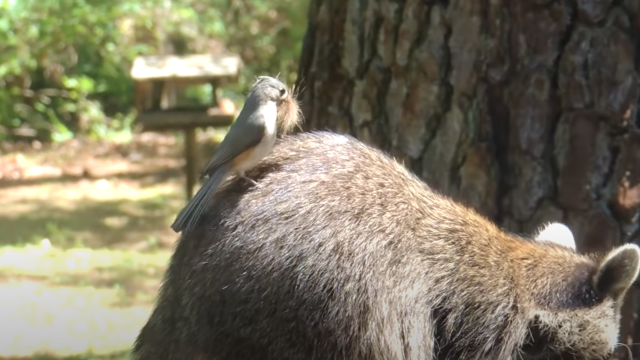Some bird species regularly pluck hair off unsuspecting animals, including humans, to make linings for their nests, scientists say. In a recent study, they detail the hair theft phenomenon, citing numerous YouTube videos that capture birds in the act. It’s not entirely clear why hair is such an appealing construction material for these birds, but it may serve to deter predators or could simply be a great insulator.
Many birds are known to use mammal hair or fur in their nests, particularly species in the family Paridae, including tits and chickadees. It’s generally assumed that these birds nab hair that had fallen off an animal or from carcasses. But researcher Jeffery Brown, a natural resources and environmental sciences professor at the University of Illinois Urbana-Champaign, one day noticed and took video of a titmouse carefully stealing tufts of hair from a sleeping raccoon (the raccoon didn’t seem to notice).
The robbery made Brown and his colleagues curious enough to look deeper into the phenomenon, which they’ve now dubbed “kleptotrichy” — which roughly translates in Greek to “hair-stealing.” Their new paper, “What the pluck? Theft of mammal hair by birds is an overlooked but common behaviour with fitness implications,” was published last month in the journal Ecology. In it, they describe the original incident (thought to be the first documented raccoon hair theft in the world of published bird science), as well as others they uncovered in subsequent research.
In the academic literature, they found only 11 examples of kleptotrichy mentioned by other scientists, with most involving the Paridae family of birds. But once they turned to the birding community and started searching for videos on YouTube, they found a treasure trove of birds caught in the act. All told, they found 99 incidents of kleptotrichy committed by birds against humans, dogs, cats, raccoons, and even one porcupine. A large majority of these sightings, including the original raccoon theft, involved the tufted titmouse (Baeolophus bicolor), but two other Paridae species were spotted in the videos, too.
The sheer number of sightings caught on tape, the researchers wrote, suggests that kleptotrichy “may be a far more common behaviour than indicated by the scientific literature.”
As for why these birds would potentially risk life and limb just to grab some hair, that’s still left to be explored. Mammal hair is known to be great at insulating against cold, so the birds may just be taking advantage of that. But it’s also possible that the odour wafted from the hairs may be enough to confuse or scare away predators and parasites that would otherwise prey on the birds, since a similar adaptation can be seen with some birds that actually add mammal poop to their nests as a deterrent.
“Unexpected interactions such as these remind us that animals exhibit all types of interesting and often overlooked behaviours and highlight the importance of careful natural history observations to shed light on the intricacies of ecological communities,” said co-author Henry Pollock, a postdoctoral researcher at the University of Illinois Urbana-Champaign, in a statement released by the university.
Whatever the reason for this odd habit, the hair is clearly tempting enough for them to risk getting caught stealing it from living targets. It’s yet another example of just how little we still understand about the lives of animals all around us.
